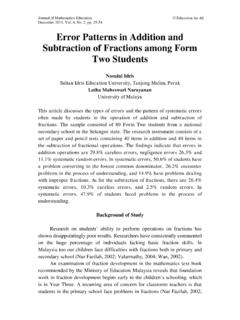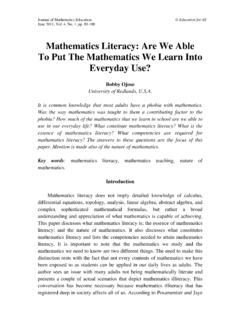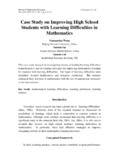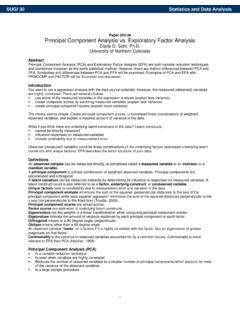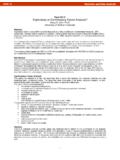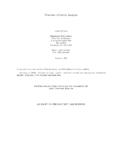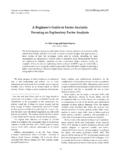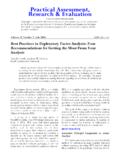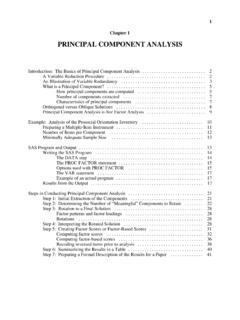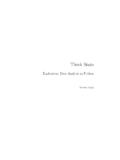Transcription of Teachers’ Perception Toward Mathematics Teaching ...
1 Journal of Mathematics Education Education for All August 2012, Vol. 5, No. 1, pp. 97-120 Teachers Perception Toward Mathematics Teaching Innovation in Indonesian Junior High School: An Exploratory Factor Analysis Turmudi Indonesia University of Education A questionnaire was developed based on a number of themes, such as the ideas to distinguish between Mathematics teacher society that have an orientation to traditional Teaching approaches and those which have an innovative orientation. The results of the study indicated that by using statistical factor analysis, 31 items were reduced to be three main dimensions. Based on the construct factors, those dimensions can be identified as constructivist Teaching , traditional Teaching , and constructivist learning factors. The dimensions are constructed by using the factor similarity.
2 As a consequences, a recommendation to conduct a special training on the realistic Mathematics Teaching approach as part of professional development program (PD) is needed. Prior to the PD session, the teachers were asked their Perception Toward innovation of Mathematics instruction. Key words: innovation, junior secondary school, realistic mathematic education Innovation in education is a lever of change which is usually conducted by innovators. In Mathematics education in particular, innovators are always offering unusual ideas. They are designing and trying out the program repeatedly to get information about the effectiveness of the programs of new Teaching approaches. Regarding the linking of Teaching and professional development programs, Farmer, Gerretson, and Lassak (2003) noted that, one of the two core premises from the Glenn report (US Dept of Education, 2000) is that better Teaching is the lever for change and effective professional development is the indispensable foundation for high quality Teaching (p.)
3 331). Roger (1983) classified people as innovators, the big majority, and the followers. In order to introduce a new idea, groups of innovators and unresistant groups of people were needed tointroduce innovations into the current situation. Therefore exploring their Perception Toward Teaching innovations of Mathematics is a necessity. 98 Teachers Perception Toward Mathematics To discuss teachers Perception Toward Teaching innovation, I need to explore the the idea of educational reforms in Indonesia. Innovations in Mathematics education in Indonesia constitute an integral part of its educational system. Some innovations which particularly focus on the Teaching and learning of Mathematics that can be used as models have been developed by proponents or educators (De Lange, 2000; Gravemeijer,2000a; Lewis, 2000; Miller & Hunt,1994; Romberg, 1992; Stein, Silver & Smith,1998; Wood & Berry, 2003).
4 Learning and Teaching strategies which challenge students to learn Mathematics need to be tested and monitored to yield the best and the most effective ways to learn and teach. This can be done by using design research (Wood & Berry, 2003), development of new instructional techniques or program (Romberg, 1992), developmental research (De Lange, 2000; Gravemeijer, 2000a), collaborative learning experience in action research (Miller & Hunt, 1994), Japanese Lesson Studies (Lewis, 2000), or reflective practice groups and communities of practice (Stein et al., 1998). All these types of innovations are guided by the strategies advocated by Curriculum and Evaluation Standards for school Mathematics (NCTM, 1989), Professional Standard for Teaching Mathematics (NCTM, 1991), Assessment Standards for School Mathematics (NCTM, 1995), Open-ended Approaches (Becker & Shimada, 1997), and the Australian Statement for School Mathematics (AEC, 1991).
5 However, current Mathematics Teaching in Indonesia still emphasizes traditional teacher -centered instruction. As stated by Zamroni (2000), Indonesian education orientation has traditionally been characterized by several points, namely, a tendency to treat students as objects, put the teachers as the highest authority holder, present courses as subject-oriented, and place management as centralized. As a consequence, educational practice is isolated from real life, with no relevance between what is taught and what is needed in the market place. It needs a stronger focus on the intellectual development of the students. In contrast, the new paradigm of education focuses on learning rather than Teaching . Education is organized in a more flexible structure, the learners are treated as individuals with certain characteristics, and education is a continuous process and interacts with the environment (Zamroni, 2000).
6 Introducing a new Teaching approach requires research to monitor and validate it. Regarding mathematical competence as an instructional goal, there is a common agreement that the final goal of student learning is the acquisition of a mathematical disposition rather than an accumulation of isolated concepts and skills. Accordingly, the way students acquire mathematical knowledge and skills should be re-organized. It must involve students in active learning (Verschaffel & De Corte, 1996). The international trend noted above leads to many new approaches for the Teaching and learning of Mathematics , such as realistic Mathematics (De Lange, 1996), open-ended Turmudi 99 approaches (Becker&Shimada,1997), and problem solving (NCTM, 2000; Silver,1989).
7 This study takes as its central focus the realistic Mathematics approach to education (RME). RME is a Teaching and learning approach to Mathematics based on problems taken from day-to-day experience rather than on abstract rules (De Lange, 2000). As this paper is part of my research thesis which focuses on the implementation of the RME in Indonesia, prior to the implementation stages, it needs to ask the teachers their Perception is towards the Teaching innovations of Mathematics , whether they welcome the new idea of Teaching Mathematics . A number of questions were asked for the teachers in order to know the Teaching atmosphere, their custom in Teaching Mathematics , their ability to encourage students learning, their comments on students thinking, their ability to encourage students to explain their strategies to solve mathematical problems, or whether the teachers instantly answer the students questions.
8 Overall to know whether the current Teaching is in the corridor of innovation, or if Teaching is still done in the conventional way. Several small studies were conducted to investigate the effect of the RME approach on the students attitude Toward Mathematics (Turmudi, 2001; Turmudi & Dasari, 2001; Turmudi & Sabandar, 2002). These were case studies, with data gathered by interviewing and observing the learners and teachers in the classroom. The results indicated that the students were motivated to learn more about Mathematics , and the students also responded to the Teaching strategies used by the teachers. Though the case studies showed promise for improvement and innovation in Mathematics education, I realize that Mathematics Teaching in Indonesia is still in a traditional perspective as mentioned by Hinduan, Hidayat and Firman (1995), Djojonegoro (1995), Somerset (1996) and Suryanto (1996).
9 This situation is relevant to the statement of Silver (1989), Romberg and Kaput (1999), Senk and Thompson (2003), and Ernest (2004). However, research data explaining the current situation is not available yet, therefore one focus of the study is to explore the teachers Perception Toward Teaching innovations of Mathematics in Indonesia. Conceptual Framework In the more traditional views, Mathematics is perceived, by most people, as a fixed, static body of knowledge (Romberg & Kaput, 1999), and the corresponding Teaching approach is viewed as a careful sequencing of tasks designed to enable students to accumulate bits of knowledge by drills on number facts and computations (Senk & Thompson, 2003). Manipulating numbers and algebraic symbols mechanically and giving proofs of axiomatic geometry are also characteristic of this approach.
10 How students obtain mathematical knowledge in the traditional Teaching approach has been called 100 Teachers Perception Toward Mathematics the copy method by Koseki (1999). However, students who memorize facts or procedures without understanding are often not sure when or how to use what they know and such learning is often quite fragile (Bransford, Brown, & Cocking, 1999). This traditional view of Mathematics can also constrain the scope of the mathematical content and pedagogy covered by the curriculum. Romberg and Kaput (1999) described traditional Mathematics classes as mostly consisting of three segments: ..an initial segment where the previous day s work is corrected. Next, the teacher presents new material, often working one or two new problems followed by a few students working similar problems at the chalkboard.
